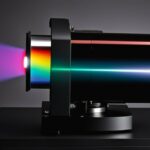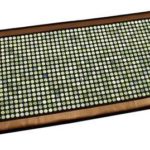Near infrared spectroscopy (NIRS) is a powerful tool used in the analysis of a wide range of materials. It has been used in a variety of industries, from food processing to pharmaceuticals, to gain greater insight into the chemical composition of materials. In this article, we’ll explore what NIRS is, the different types of NIRS, and the benefits of using this tool. We’ll also look at some of the applications of NIRS in the real world and how it can be used to analyze different materials. So, if you’re interested in learning more about NIRS, read on!
Near Infrared Spectroscopy (NIRS) is a spectroscopy technique used to identify and measure the absorption of near-infrared light by a sample. It is widely used in the food industry to detect the moisture, fat, and protein content of food products, as well as in the pharmaceutical industry to measure the concentration of drug components in tablets. NIRS also has applications in biomedical research, such as the detection of oxygen concentration in tissue, and in environmental monitoring.

Contents
What is Near Infrared Spectroscopy?
Near infrared spectroscopy (NIRS) is a technique used to analyze the composition and structure of materials, both organic and inorganic. It is a non-destructive method of chemical analysis that is based on the absorption and emission of infrared energy by molecules. The technique has been used for many years in industrial and research applications and is becoming increasingly popular in the medical and pharmaceutical fields.
NIRS works by measuring the intensity of infrared light passing through a sample. The intensity of the light is then used to calculate the concentrations of various substances in the sample. This data can then be used to identify the chemical composition of the sample, as well as its physical properties. NIRS is also used to measure the physical properties of materials, such as their optical properties, thermal properties, and electrical properties.
NIRS is a type of spectroscopy that uses infrared radiation to measure the absorption and emission of light by molecules. The technique is based on the principles of quantum mechanics, which allow scientists to measure the energy levels of molecules. This information is then used to determine the composition of the sample and its physical properties. NIRS can be used to measure the concentration of various compounds in a sample, as well as to identify chemical reactions that occur within the sample.
Advantages of Near Infrared Spectroscopy
NIRS is a fast and cost-effective method of analyzing materials and is especially useful for analyzing large samples. The technique is also non-destructive, which means that samples can be analyzed without causing any damage to the sample. This makes NIRS ideal for applications such as food safety and quality control, as well as medical and pharmaceutical analysis.
NIRS is also a relatively simple technique to use. It does not require any special equipment or training and can be carried out in the laboratory or in the field. The technique is also highly accurate and reproducible, which makes it well suited for industrial and research applications.
Limitations of Near Infrared Spectroscopy
NIRS is limited in its ability to measure substances that are not infrared-active, such as metals and minerals. The technique is also limited in its ability to measure very small concentrations of substances, such as trace elements. Additionally, the technique is not suitable for measuring the optical properties of materials, such as their refractive index or absorption coefficient.
Applications of Near Infrared Spectroscopy
NIRS is used in a wide range of industrial and research applications, including food safety and quality control, pharmaceutical analysis, and medical diagnostics. The technique is also used in the petrochemical industry to identify hydrocarbons and other compounds in crude oil and petroleum products. Additionally, NIRS is used in the agricultural industry to identify and measure the concentrations of various compounds in crops and soil.
Conclusion
Near infrared spectroscopy (NIRS) is a powerful and versatile technique used to analyze the composition and structure of materials. The technique is fast, non-destructive, and cost-effective, making it ideal for industrial and research applications, as well as medical and pharmaceutical analysis. NIRS is also relatively simple to use and can be carried out in the laboratory or in the field. While the technique is limited in its ability to measure certain substances, it is still a valuable tool for analyzing a wide range of materials.
Related Faq
What is Near Infrared Spectroscopy?
Answer: Near Infrared Spectroscopy (NIRS) is an analytical technique used to measure the absorption of infrared light by molecules. It is used to assess the chemical and physical properties of materials, including the composition, structure and concentration of molecules. NIRS is a non-destructive technique that does not require any sample preparation and can provide rapid results.
What are the Benefits of Near Infrared Spectroscopy?
Answer: Near Infrared Spectroscopy (NIRS) offers a number of advantages over traditional analytical methods. It is a fast, non-destructive, and cost-effective technique that provides rapid results. It is also able to accurately measure trace amounts of materials and can be used to monitor chemical and physical changes in real-time. Additionally, NIRS can detect a wide range of compounds and can be used to analyze a variety of sample types.
What Types of Samples can be Analyzed with Near Infrared Spectroscopy?
Answer: Near Infrared Spectroscopy (NIRS) can be used to analyze a wide range of sample types, including solids, liquids, and gases. These samples can be opaque, transparent, or semi-transparent. The technique is particularly useful for analyzing food and agricultural products, pharmaceuticals, and petrochemicals.
How Does Near Infrared Spectroscopy Work?
Answer: Near Infrared Spectroscopy (NIRS) works by measuring the absorption of infrared light by molecules. A light source, typically a laser or lamp, is used to illuminate the sample and a detector measures the amount of light that is absorbed. The light is then analyzed to determine the concentration of molecules within the sample.
What are the Limitations of Near Infrared Spectroscopy?
Answer: Near Infrared Spectroscopy (NIRS) is a widely used analytical technique, but it does have some limitations. NIRS is not able to differentiate between compounds with similar molecular structures, and it is not able to measure thick samples. Additionally, NIRS is sensitive to sample preparation and can be affected by a variety of environmental factors.
What are Some Applications of Near Infrared Spectroscopy?
Answer: Near Infrared Spectroscopy (NIRS) is widely used in a variety of industries. It is commonly used to analyze food and agricultural products, pharmaceuticals, and petrochemicals. It is also used to monitor chemical and physical changes in materials, and can be used to assess the quality of products. Additionally, NIRS is increasingly being used in medical diagnostics, to monitor drug efficacy and to detect diseases.
Near Infrared Spectroscopy (NIRS) is an invaluable tool for scientists and researchers looking to gain a better understanding of the material world. Its ability to detect and analyze the composition of a wide range of materials makes it one of the most powerful spectroscopy techniques available. NIRS is an efficient, non-destructive and cost-effective way to analyze materials rapidly, giving researchers an unprecedented level of insight and control over their work. With its versatile capabilities, Near Infrared Spectroscopy is an invaluable tool for any research laboratory.








